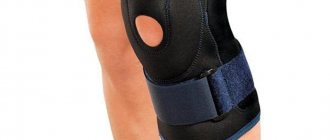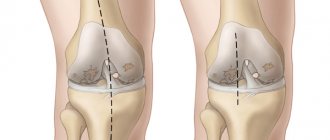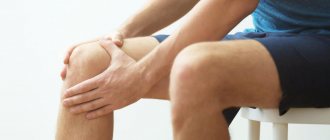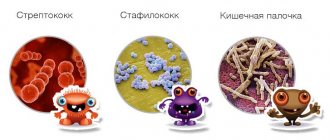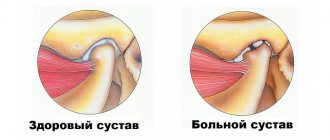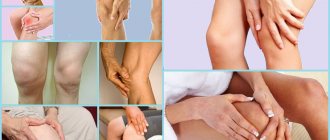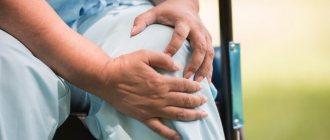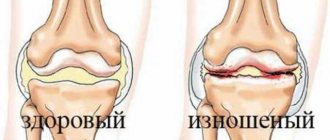Synovitis of the knee joint is an inflammatory process limited to the joint membrane of the lower limb. A characteristic feature of the development of the pathological process is the accumulation of fluid in the joint, which significantly reduces the functionality of the knee.
Among the key reasons are previous injuries, as well as other joint pathologies and various metabolic disorders, including infectious lesions.
The main clinical manifestations are pain, the intensity of which increases when attempting to perform a movement, as well as swelling and an outwardly noticeable increase in the size of the localization site.
The diagnosis is made based on the patient’s existing complaints, visual examination, as well as the results of the study (laboratory/instrumental).
The treatment plan for each patient is determined individually, in accordance with the existing symptoms and his state of health.
How to treat synovitis of the knee joint: general principles
After examination and diagnosis, the optimal method of therapy is selected, which depends on the type and stage of inflammation, as well as the individual health characteristics of the patient.
An integrated approach includes:
- performing a puncture;
- fixing the immobility of the affected knee joint;
- taking medications;
- physical therapy;
- traditional medicine methods.
Surgical intervention is indicated in the absence of results of conservative treatment.
Each form of synovitis of the knee joint has its own characteristics and subtleties of treatment, requiring a special approach and detailed analysis of all the nuances.
Signs of a non-infectious form of the disease
The main symptoms of an aseptic type of disease are an increase in the volume of the knee joint and the absence of pain. This phenomenon is caused by the fact that the synovial fluid, located in the joint capsule when the synovial membrane is irritated, sharply increases in quantity in just a few hours. The resulting swelling in the knee joint prevents free movement.
Symptoms of the aseptic type have the following form:
- an increase in volume occurs from several hours to 1-2 days;
- the affected area does not have a high temperature;
- when pressing on the patella bone, it sinks into the joint, after which it floats up again;
- general weakness.
Taking medications
Only medications prescribed by the attending physician are indicated for use:
- NSAIDs. Relieves pain, reduces the severity of the inflammatory process;
- Antiviral drugs. In the event that the tests performed reveal the viral nature of the disease;
- Antibiotics. Cures lesions caused by bacterial infection;
- Antihistamines. Relieves allergic manifestations.
- Immunostimulants, vitamin-mineral complexes, dietary supplements. Restores the immune system and strengthens the body.
Folk remedies that help with synovitis
To treat diagnosed synovitis of the knee joint of a non-dangerous form, you can use some traditional medicine:
- lotions based on herbal decoctions;
- rubbing with medicinal tinctures;
- taking herbal teas or herbal decoctions;
- ointments made from animal fats.
Any means are used only as an addition to the main treatment prescribed by a medical specialist. A combination of drug therapy, physical therapy and home treatment can provide an accelerated positive effect.
Let's consider the main types of research.
X-ray of the joint
Radiography is considered one of the simplest, inexpensive and fastest methods. An X-ray will help the doctor identify the inflammatory process in the synovium of the joint, based on a visual determination of the amount of fluid in the joint. X-rays also help determine the size of the joint space and the condition of the joint surfaces. Basically, doctors prescribe studies of both joints (healthy and diseased) in order to compare and identify the degree of inflammation.
Ultrasound examination of the joint
A joint ultrasound is a non-invasive test (does not damage tissue) that helps identify the cause and extent of joint damage. This diagnostic method also helps to find out the thickness of the synovial membrane, the volume of specific fluid that filled the joint, as well as determine the condition of the articular surfaces and tissues. It should be emphasized that ultrasound and x-rays, unlike puncture, can be used to diagnose synovitis in children.
Joint puncture
Joint puncture is considered the most effective diagnostic option, as it helps determine the type of fluid obtained through bacterial examination (microorganisms can be detected in the synovial fluid). Also, with the help of this study, you can detect bloody discharge, fibrin, pus and much more. In order to perform a puncture, the skin in the puncture area is thoroughly treated with a 5% iodine solution, and then wiped with 70% alcohol. This is due to the fact that iodine during puncture can enter the synovial membrane and cause chemical reactions. burn. It should be noted that the research method and the patient’s position during puncture of different joints are different. So, for example, puncture of the knee joint can be performed at one of four points.
Surgery
The minimum intervention in the body is arthroscopy, a procedure to clarify the condition of the organ, clarify the diagnosis, and also perform a biopsy of damaged tissue. The therapeutic effect of arthroscopy is to reduce swelling due to drug treatment of the internal cavity of the joint.
Complete or partial removal of the affected tissue is carried out during synovectomy. The operation is indicated for patients with dangerous forms of the disease, an acute unpredictable course of the disease, as well as chronic, often recurrent synovitis. The operated joint is immobilized for a week, but movement is possible already on the second day after the intervention. Rehabilitation is long.
Causes
Inflammation of the synovial membrane can be provoked by:
- Injuries that result in constant irritation of the inner lining of the joint by pieces of cartilage or damaged meniscus.
- Infections that penetrate into the joint cavity from the external environment (in case of injury) or from neighboring tissues (in the presence of phlegmon, abscesses, wounds, abrasions, boils, etc.). Pathogenic microorganisms can also enter the joint from distant foci of infection via lymph or blood flow.
- Congenital and acquired pathologies of the joint and periarticular tissues. They lead to the development of synovitis for various reasons. For example, with rheumatoid polyarthritis or rheumatism, the disease develops under the influence of antibodies that affect the synovial membrane, and with arthrosis - due to irritation of this membrane by cartilage, which has lost its smooth surface, or bone growths.
- Autoimmune diseases (lupus erythematosus, rheumatoid arthritis). The immune system perceives the inner lining of the joint as a foreign agent, and antibodies begin to gradually destroy it.
- Metabolic disease. This cause causes synovitis, because metabolic products accumulate in the joint cavity, irritating the membrane.
- Allergic reactions. When allergens penetrate into the joint capsule, they are perceived as dangerous antigens, and the immune system begins to produce antibodies, resulting in inflammation, accompanied by excessive formation of synovial fluid.
- Endocrine diseases. Hormonal disruptions lead to the fact that synovial fluid begins to be produced in large quantities. Because of this, inflammation of the inner lining of the joint develops.
- Hemophilia. With this disease, constant hemorrhages occur in the joint cavity, which causes inflammation.
- Diseases of the nervous system. This is caused by severe stress, pinched or damaged nerves due to scoliosis, neoplasms or fractures, as well as neuritis of peripheral nerves.
There are 2 stages observed during the course of the disease:
- Spicy. Symptoms progress progressively: swelling, pain, and redness intensify during the first few days.
- Chronic (recurrent). Observed in the absence of adequate and timely treatment of the disease; The main symptom of chronic synovitis is dropsy and periodic mild pain.
Rehabilitation and exercise therapy
To speed up the restoration of limb mobility to the previous extent after conservative or surgical treatment of synovitis, physical therapy exercises are recommended. The time frame for starting them is determined by the attending physician.
For classes, a special set of exercises that do not cause pain is selected. The goal is to eliminate high stress on muscles and joints. Exercises are carried out from static positions lying or sitting, affecting relaxation or stretching of muscles. Regular exercise increases physical endurance and makes tendons elastic.
The positive effect of gymnastics is to reduce pain, stabilize the production of synovial fluid, expand the range of organ mobility, and create a positive attitude toward recovery.
Positive progress in well-being can be consolidated by walking, as well as exercising on an exercise bike or elliptical machine.
Prevention of synovitis
To prevent a relapse, you must not forget about preventive measures. Prevention is a set of rules and measures that will help maintain the health of your lower extremities.
When playing sports, do not forget to be careful, this will help protect your knee from injury. Also, special attention should be paid to the choice of shoes, not only those in which you train, but also everyday ones. Having the right shoe collection will protect you from future injuries. Professional athletes should fix the articular surfaces with special pads or bandages. Contact us if you have severe or moderate synovitis, we will help. We employ qualified specialists. Prices can be found in the price list on the website or by calling +7,).
Prognosis for the course of the disease
For a favorable prognosis, factors such as the condition of the patient’s body, as well as timely effective treatment, are important. Complete recovery with preservation of the same motor activity is possible with the mildest forms of the lesion, as well as with the serous or allergic variant of the disease.
The severe course of the purulent form poses a threat to life, since a septic lesion develops. With the most favorable developments in this case, there is a high probability of stiffness or complete immobility of the affected organ, as well as dangerous complications on other organs and systems of the body.
Nutrition
The fundamental principles of treating synovitis include diet:
- Gradual weight loss is a prerequisite for successful therapy. Losing weight reduces the stress on your joints.
- Eat frequently 4-5 times a day, but in small portions, consume protein of animal or plant origin daily: meat, beans, lentils.
- Carry out fasting days once a week - a diet in the form of fruits, vegetables, lactic acid products.
- Normalize metabolic processes - exclude grape acids and easily digestible carbohydrates from the diet: chocolate, grapes, wine. Eat seafood, seaweed, plant foods, especially red and green vegetables.
Salt - of course, you don’t need to completely give it up, but reduce your consumption to 1 gram. per day is necessary.
Clinic of Dr. Dlin in Moscow: treatment of synovitis of the knee joint
Prevention and treatment of the disease are one of the key areas of activity of a medical institution. Patients have access to a full course of therapy from specialized diagnostics, identification of causes, elimination of pain, to elimination of the causes of pain. Our specialists have undergone specialized training and specialization in the world's leading clinics and have extensive positive experience in this area.
Clinic offer:
- international level of therapy using the latest innovative developments;
- modern diagnostic, laboratory and treatment equipment;
- collaboration of a group of experienced specialists in the field of synovitis;
- rapid relief of pain;
- comfortable cozy atmosphere and attentive staff.
Call and register for a free initial medical appointment!
Acute symptoms
Acute synovitis of the knee joints can be accompanied by severe pain. Therefore, if you suspect an infectious form of the disease, it is extremely important to consult a doctor as soon as possible, who will identify the causative agent of the infection and prescribe the necessary therapy.
Symptoms that accompany the acute purulent form:
- the joint is increased in volume;
- increased body temperature;
- general condition is characterized by weakness and nausea;
- there is pain when flexing and extending the leg;
- there is redness in the knee area, which turns out to be hot on palpation.
The disease is especially acute with a pyogenic infection. Pathogenic bacteria often penetrate into the joint cavity along with the bloodstream or through open wounds. Accumulated blood, pus and joint fluid cause stretching of the joint capsule, which causes pain.

